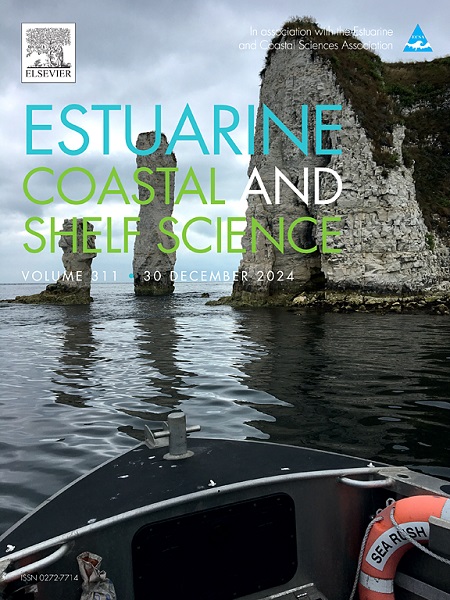富营养化和多重压力对河口鱼类健康状况影响的脂肪酸分析
IF 2.6
3区 地球科学
Q1 MARINE & FRESHWATER BIOLOGY
引用次数: 0
摘要
本研究的独创性在于使用鱼类脂质标记物,突出了脂肪酸谱作为生物标记物评估富营养化或多重胁迫下河口系统健康状况的重要性。在本文中,我们建立了一种结合欧洲比目鱼幼鱼肌肉脂类和脂肪酸分析、流域地理指标和沉积物污染物水平的方法,以评估流域内主要受农业活动影响的7个小河口的生态状况。河口比目鱼肌肉中脂肪酸组成对比。多不饱和脂肪酸(PUFA)比例的显著差异,特别是二十二碳六烯酸(DHA)和二十二碳五烯酸(DPA),不仅反映了细胞膜的状态,也反映了食物来源的质量差异。高水平的多聚脂肪酸与较好的生态条件有关,而低含量的多聚脂肪酸显然与富营养化和多重胁迫有关。此外,在受鱼类养殖影响较大的系统中,可以清楚地发现比目鱼脂肪储备含量较高,这反映了整个营养链受到水产养殖废弃物的污染。本文章由计算机程序翻译,如有差异,请以英文原文为准。

Fatty acid analysis in an estuarine fish species to assess the health status of hydrosystems impacted by eutrophication and multistressors
The originality of this research lies in the use of fish lipid markers, which highlights the importance of fatty acid profiles as biomarkers to evaluate the health status of estuarine systems subject to eutrophication or multistress. In the present paper, we developed an approach combining lipid class and fatty acid analyses on juvenile European flounder muscle, watershed geographic metrics and pollutant levels in sediments, to assess the ecological status of seven small estuaries mainly impacted by agricultural activities in the watersheds. The estuaries showed contrasted fatty acids compositions in flounder muscle. Marked differences in polyunsaturated fatty acid (PUFA) proportions, particularly docosahexaenoic acid (DHA) and docosapentaenoic acid (DPA), reflected not only the state of cell membranes but also variations in the quality of food sources. High levels of PUFA were associated with better ecological conditions, while reduced PUFA availability was clearly linked to eutrophication and multistress. In addition, higher flounder lipid reserve content was clearly identified in the system highly impacted by fish farming, reflecting a contamination of the entire trophic chain by aquaculture waste.
求助全文
通过发布文献求助,成功后即可免费获取论文全文。
去求助
来源期刊
CiteScore
5.60
自引率
7.10%
发文量
374
审稿时长
9 months
期刊介绍:
Estuarine, Coastal and Shelf Science is an international multidisciplinary journal devoted to the analysis of saline water phenomena ranging from the outer edge of the continental shelf to the upper limits of the tidal zone. The journal provides a unique forum, unifying the multidisciplinary approaches to the study of the oceanography of estuaries, coastal zones, and continental shelf seas. It features original research papers, review papers and short communications treating such disciplines as zoology, botany, geology, sedimentology, physical oceanography.

 求助内容:
求助内容: 应助结果提醒方式:
应助结果提醒方式:


